renewal cycles. Complete
some now & some later.
and Get 25% off
the Total price!
Buy 3 Courses
and Get 30% off
the Total price!
Buy 4 Courses
and Get 35% off
the Total price!
| Create Account | Login | ||

Section 18
5 Types of Yarn Winding
Table of Contents | NCCAP/NCTRC CE Booklet
Spool Winding
There are five different formats for Yarn Winding. The first type of Yarn Winding I will explain is an activity in which the resident winds yarn to which a spool has been attached. I call this activity Spool Winding. The second type of yarn winding is Yarn Winding on a Donut Shape. The third type is Yarn Winding on a Tube. The fourth type is Yarn Winding on a Pringles Can. The fifth type is Yarn Winding into a Ball. Let's start by talking about Spool Winding first.
 As the picture illustrates, the idea behind Spool Winding is to wind and unwind the yarn around the paper towel, or similar, cardboard tube to raise and lower the empty spool of thread. I created the idea of Spool Winding because I interviewed so many residents that had stiff fingers; and wanted to develop something to encourage the residents to move their fingers, but was at no cost; so the activity could be left in an Activity Project Bag in the resident's room.
As the picture illustrates, the idea behind Spool Winding is to wind and unwind the yarn around the paper towel, or similar, cardboard tube to raise and lower the empty spool of thread. I created the idea of Spool Winding because I interviewed so many residents that had stiff fingers; and wanted to develop something to encourage the residents to move their fingers, but was at no cost; so the activity could be left in an Activity Project Bag in the resident's room.
Observe and Assess! For the activity of Spool Winding, you need a paper towel tube or perhaps a cardboard tube from gift wrapping. However, all cardboard tubes are not created equal. As you will find, a Pringles can or a salt container can work for some residents, depending on…
1. the size of your resident's hands
2. their ability to grasp an object with this wide diameter, and
3. the amount of stiffness or contracture in their fingers.
You then need to decide upon the length of the yarn. You might start with yarn about fifteen inches long. Styrofoam spools are the best for three reasons:
1. Spools are too big to swallow;
2. If the resident flings the Styrofoam around, the impact will not be too damaging;
3. The spools are free. Consider putting a sign up by your time clock and by your Volunteer Sign-In Book requesting spools. If you cannot acquire any empty spools, try three inch to five inch Styrofoam balls.
Here's how Spool Winding works. Take the yarn and tie it to the center of the cardboard tube. Then take the other end of the yarn and tie it through the center of the spool. The idea, obviously, in spool winding is to wind and unwind the yarn around the cardboard tube to enable the spool to move up and down.
The purpose of the spool is simply to add weight to the end of the yarn. I had a male resident for whom the activity director made a construction paper fish in place of the spool, and he said he was reeling in his fish. He was actually having so much fun with this and had so much mental and physical capability, that the piece of yarn was about 2 or 3 yards long. The Activity Director would lay the fish on the floor in front of him. With a huge smile on his face, the resident would say, "I am reeling in my fish." Of course initially the Activity Director started with a shorter length of yarn, but was flexible enough to evaluate that when a fifteen inch piece of yarn offered no challenge, she continually increased the length. Think back to the Push Ball activity described earlier and the challenge laid down to you to "Brainstorm about Adaptations." Do you see how this Activity Director applied her abilities of…
1. Observation regarding the length of yarn being too short and not enough of a challenge for that resident
2. Assessment of his interest in fishing and stamina to wind increasingly longer lengths of yarn i.e. Person Appropriate. See additional assessment procedures below.
3. Creativity: Made and affixed the fish, as well as continually changed the length of the yarn
4. Sensitivity to her resident's capabilities and limitations.
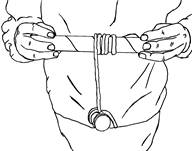 Adaptations for Success: One way to vary the difficulty in spool winding is to vary the diameter of the tube to be wound. A second way to vary the difficulty of spool winding is, as mentioned above, to vary the length of the yarn. A smaller diameter tube, for example a paper towel tube, will require more turns to wind the same length of yarn, as compared to a wider diameter tube, for example a Pringles can. However, even though the smaller diameter tube requires more turns, the smaller diameter may be easier for the resident to grasp, because his or her fingers are starting into a contracture and closing.
Adaptations for Success: One way to vary the difficulty in spool winding is to vary the diameter of the tube to be wound. A second way to vary the difficulty of spool winding is, as mentioned above, to vary the length of the yarn. A smaller diameter tube, for example a paper towel tube, will require more turns to wind the same length of yarn, as compared to a wider diameter tube, for example a Pringles can. However, even though the smaller diameter tube requires more turns, the smaller diameter may be easier for the resident to grasp, because his or her fingers are starting into a contracture and closing.
When introducing this activity to a resident, to motivate him or her to do the activity, you might say something like, “Martin, I’ve got a hand exercise for you to do. Would you like to do a hand exercise for me today? This is a hand exercise.” He may reply, "No, I can't exercise! I am too old." You might reply, "This is just a simple hand exercise. See all you have to do is turn the tube." Then I demonstrate.
When assessing a resident’s ability to do Yarn Winding, get at eye level and get the resident's eye contact before you start the activity. If you are unfamiliar with the residents hands, ask him or her to place their hand flat in yours. By seeing how flat he or she can lay the hand, you are assessing
1. If the resident has the mental ability to follow a simple direction
2. If they have the hand movement necessary to do the activity you are thinking of having them try.
Line of Vision Reminder: The next step after assessing mental ability regarding the resident’s ability to follow a simple direction and hand movement, is demonstration of the activity.
1. I state, “Martha, look what I have here.”
2. However, I need to stay in the Martha's line of vision.
3. I hold the spool and tube in her line of vision, all the time keeping eye contact with Martha.
4. I notice where she is looking. If she happens to look to the right or turn her head to the right and I have the Spool winding to the left of her mid-line, I then move the Spool Winding activity back into her line of vision. For a resident who has a short attention span, this is extremely important to assess exactly where they are looking, because they clearly cannot say, "Hey, I have Alzheimer's and my attention span is so short. I am not maintaining eye contact with what you are talking about. Please regain my attention by moving the Spool Winding back in my new line of vision now that I am glancing in a new direction." Get the point? J
5. Once I feel Martha is looking at the Spool Winding tube again I say, “What do you think of this?”
6. I try to get a reaction or a communication… perhaps a change in facial expression, noise, or a word.
7. Then I say, “This is a hand exercise.” I demonstrate.
8. Then I say, "Here you try," as I place the tube into the resident's hands. I may mold my hand around hers and initially turn the tube for her and say "Good! Great, good! You are really helping out your hands by moving them." Hopefully, if Martha has enough mental capability, she will start to turn the tube herself.
| Goal: To wind a 10" piece of yarn… |
Goal: To wind and unwind a15" piece of yarn... |
Goal: To wind spool independently once started… |
The higher level of use of Spool Winding can be an activity for your more alert residents. The problem is their hands could benefit from the movement, but the Activity is clearly nonsensical and non-product producing. I have had success with residents who are completely alert but who have had a stroke and their hands have limited movement. Here's how I motivate them to try this seemingly nonsensical activity. I state, “Winding the yarn on this spool seems kind of silly or foolish. But this will help you with your hands. I noticed that your fingers are stiff. Let’s see if you can do this. Would you like to try winding the yarn on this tube to exercise you stiff fingers for a few minutes? Here's how it works.” I then demonstrate Spool Winding.
Spool Winding is a notch in a subjective Difficulty Scale above Caps-in-a-Bowl, explained in detail in Volume One in this Series, because Spool Winding requires a continuous effort. Caps-in-a-Bowl just requires a few seconds of attention to drop the gallon milk bottle cap into the bowl. However, in the case of Spool Winding, the resident needs to hold the concept of what they are doing in their mind over the course of the activity. If they have an attention span of less than 10 or 15 seconds, I find the resident makes a couple of turns of the tube then stares into space unaware what to do next. Obviously since the goal is success, this low level of resident is not a good candidate for Spool Winding on this particular day or at this time of day. You might try again or decide to have them do something that does not require a sustained level of attention, like Caps-in-a-Bowl or patting a ball of clay flat, explained in detail in Volume Two of this Series.
Residents with whom to try Spool Winding
| Resident | Who will gather materials and/or construct project? |
Staff /Volunteer to work with resident? When? |
|
|
|
|
|
|
Progress Note: See page 7 for details regarding this four-part implementation procedure, which can become the basis of a Progress Note, stating “When I tried Spool Winding with _________________, the following occurred… |
1. Observation: |
2. Assessment: |
3. Creativity: |
4. Sensitivity: |
Culture Change Implementation: Place Spool Winding in labeled Activity Project Bag left in resident’s room for CNA, volunteer, etc. use.
Yarn Winding on a Donut
(The last track of the DVD contains slide(s) illustrating implementation of this activity.)
The name of this project comes from the shape onto which the resident is winding the yarn. To make the donut form around which the yarn is wound, take a butter tub or Dream Whip type-lid and cut about a 1 1/2" diameter hole in the center of the lid. Remember, projects are made from low or no cost materials to encourage you to leave them in the residents’ rooms available for all staff, family, etc. in Activity Project bags.
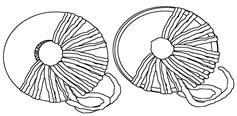 Another option is using donut shapes cut from corrugated cardboard. The outer circle could be about 5”-6" in diameter, the inner circle that you would cut out would be about 1 1/4” to 1 1/2”. Of course, in light of your challenge to Observe and Assess, experiment with different diameters. One resident may be able to work better with donuts made from larger Cool Whip container lids. However, another resident may experience more success doing yarn winding with the donut shape made from the smaller butter tubs.
Another option is using donut shapes cut from corrugated cardboard. The outer circle could be about 5”-6" in diameter, the inner circle that you would cut out would be about 1 1/4” to 1 1/2”. Of course, in light of your challenge to Observe and Assess, experiment with different diameters. One resident may be able to work better with donuts made from larger Cool Whip container lids. However, another resident may experience more success doing yarn winding with the donut shape made from the smaller butter tubs.
Here's an example of how to implement Yarn Winding on a Donut.
1. First of all, assess the resident's ability by getting at eye level and establishing eye contact.
2. Then initiate a conversation by saying something like, “Marie, my name is Cathy. Have you always lived in Ellettsville?”
3. Then assess your Marie's ability to maintain eye contact and answer this and other simple questions.
4. This gives you an idea of the length of Marie's attention span for this particular session. Usually, someone of the ability level to succeed at Yarn Winding on a Donut has to have at least a one minute attention span, as well as the ability to maintain eye contact when spoken to, and the ability to understand some words.
5. As mentioned earlier, the next step may be to ask your Marie to place her hand flat on yours to assess whether she is able to understand a simple direction, as well as for you to assess her hand movement. If your Marie meets these criteria, perhaps she is a good candidate for Yarn Winding on a Donut shape.
6. The next step is, after demonstrating, place the donut shapes in her hand. Next, consider positioning…
Positioning of Yourself
If your resident and you are both right handed, it is important to stand on the right side of the resident. This seems a little awkward for you, I admit. But if you stand directly in front of your resident, in the hand shaking position, your forearm or hand may be blocking the line of vision of the resident. This concept is illustrated in the Three Piece Puzzle section of this Manual.
Then demonstrate, showing her how a length of yarn is wrapped around the outside of the dough-nut shape and up through the center hole. Some residents are only able to do parts of this winding process.
1. Some residents are unable to push the yarn through the hole.
2. Some residents are only able to pull the yarn through the hole from the under side.
3. Some residents are only able to pull the yarn through the hole from the under side once you have started it through. They are then able to hook an index finger around the loop and pull in through as illustrated.
4. You might need to hook their index finger around the loop of the yarn that is poking up through the center. They are then able to pull through the piece of yarn.
| Goal: To pull yarn though center hole of donut shape with physical assistance… |
Goal: To push yarn though center hole of donut shape with physical assistance… |
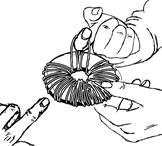 I like to use pieces of yarn that are about 1 yard in length. Usually, I take a 2 yard piece and fold it in half, so Marie is actually pulling a double strand of yarn through the dough-nut shape. I then, of course, compliment her by saying sincerely, “Good, great. You really did a good job by pulling that yarn through. Let’s see if you can do that again.”
I like to use pieces of yarn that are about 1 yard in length. Usually, I take a 2 yard piece and fold it in half, so Marie is actually pulling a double strand of yarn through the dough-nut shape. I then, of course, compliment her by saying sincerely, “Good, great. You really did a good job by pulling that yarn through. Let’s see if you can do that again.”
Observe and Assess! To assist a one handed resident in doing Yarn Winding on a Donut independently, you might clamp the donut shapes to an over-the-bed-table. For your residents who can function for a few minutes independently once started, Spool Winding and Yarn Winding on a Donut are excellent projects to be placed in Activity Project Bags in the residents’ rooms because this project is at no cost, and is not messy. Write a note on the Activity Project Bag with a few words telling the visitor, volunteer, or staff member what to do to get the resident started.
| Goal: To do Yarn Winding independently once started… |
Goal: To do Yarn Winding independently… |
Goal: To do Yarn Winding with total physical assistance… |
Goal: To do Yarn Winding and pull through the loop with physical assistance… |
Adaptation Using Scent Therapy: If the resident is not alert when you start to work with her on the Yarn Winding, or any other project as far as that goes, you might have her smell, for example, vanilla extract or mint extract to wake her out of her somewhat stupor-like sleep. Have you found, like I, that using lemon extract prior to starting this project is a relatively pleasant smell that helps the resident to be more mentally stimulated and prepared for the mental exercise of the activity?
Pom-pom Ball Snowmen
(The last track of the DVD contains slide(s) illustrating implementation of this activity.)
If you wish to motivate a more alert resident by making a pom-pom ball craft project out of Yarn Winding, here's a suggestion. Place two identical cardboard donut shapes together around which the resident winds the yarn. After the yarn is wound around the entire donut shape, with more than one layer, you then slip the blade of the scissors between the two donuts and cut the outside edge. Then slip a strong piece of string or wire between both of the cardboard disks to pull together your pom-pom ball. The next step is to remove the yarn from the donut and trim into a sphere. This is a great activity for the residents who are alert enough to be aware of having created a finished product. As illustrated in the photo on the last track of the DVD, by adding felt features, you can use your imagination to produce a chicken, a rabbit, a snowman, a turkey, etc.
Residents with whom to try Yarn Winding on a Donut
| Resident | Who will gather materials and/or construct project? |
Staff /Volunteer to work with resident? When? |
|
|
|
|
|
|
Progress Note: See page 7 for details regarding this four-part implementation procedure, which can become the basis of a Progress Note, stating “When I tried Yarn Winding on a Donut with _________________, the following occurred… |
1. Observation: |
2. Assessment: |
3. Creativity: |
4. Sensitivity: |
Culture Change Implementation: Place Winding on a Donut in labeled Activity Project Bag left in resident’s room for CNA, etc. use.
Yarn Winding on a Paper Towel Tube
(The last track of the DVD contains slide(s) illustrating implementation of this activity.)
The third kind of Yarn Winding, in addition to Spool Winding and Yarn Winding on a Donut Shape, is Yarn Winding around a Tube. Obviously the object of this activity is simple. The resident is to wind the yarn around a paper towel tube. I find the tubular shape works well. However, you might experiment with other shapes and sizes of containers around which yarn might be wound.

If you are using a paper towel tube or wrapping paper tube, cut the tube in half or in thirds, a C-clamp, purchased from a hardware store, might work to hold the crushed end of the paper towel tube in place for a one-handed resident. If you C-clamp the paper towel tube to an over-the-bed-table, the resident then winds the yarn either towards or away from themselves around the tube. Observe your resident to see which direction of winding is easiest. Not familiar with C-clamping low-functioning activity projects? The last track of the DVD shows a slide of a C-clamp in use for another project.
To initiate Yarn Winding on a Tube as mentioned previously…
1. Get eye contact from the resident.
2. Position yourself at his or her eye level.
3. Assess the resident's mental ability to understand the idea of Yarn Winding for this session.
4. Assess motor ability to move your Frieda’s hands to do Yarn Winding by asking your resident to close and open her hands.
5. To motivate you might say, “Frieda, let's see if you can wind this yarn around the tube. I bet you used to work with yarn when you were younger.”
 So how do you stabilize the ball of yarn from which Frieda is winding? I like to place the ball of yarn in a cottage cheese container or coffee can to stabilize the ball from rolling around. The photo on the last DVD track illustrates positioning of a container. If your resident is right handed you might place the yarn container to your resident's right. Thus, the ball of yarn is on the floor in the container next to their chair on the right, as illustrated.
So how do you stabilize the ball of yarn from which Frieda is winding? I like to place the ball of yarn in a cottage cheese container or coffee can to stabilize the ball from rolling around. The photo on the last DVD track illustrates positioning of a container. If your resident is right handed you might place the yarn container to your resident's right. Thus, the ball of yarn is on the floor in the container next to their chair on the right, as illustrated.
Note: Before the resident starts the yarn winding, you might anchor the end of the yarn onto the tube with tape or wind the yarn a few times yourself to avoid sliding. Yarn winding on a tube can also be used to make pom-pom balls for a craft project by sliding the wound yarn off the tube; tying the loops in the center with a strong string or wire; and then cutting the loops at the ends.
| Goal: To wind yarn on tube for three times around… |
Goal: To wind yarn on tube for six times around… |
Residents with whom to try Yarn Winding on a Tube
| Resident | Who will gather materials and/or construct project? |
Staff /Volunteer to work with resident? When? |
|
|
|
|
|
|
Progress Note: See page 7 for details regarding this four-part implementation procedure, which can become the basis of a Progress Note, stating “When I tried Yarn Winding on a Tube with _________________, the following occurred… |
1. Observation: |
2. Assessment: |
3. Creativity: |
4. Sensitivity: |
Culture Change Implementation: Place Winding on a Tube in Activity Project Bag left in resident’s room for CNA, volunteer, etc. use.
Yarn Winding on a Pringles Can
Now that we've talked about Yarn Winding on a Tube, let's look at Yarn Winding on a Pringles Can. Yarn Winding on a Pringles Can requires a totally different type of hand and arm movement because the resident is winding around a vertical object. With Yarn Winding on a Tube, the resident is winding the yarn around a horizontal object. Five slides on the last track of the DVD illustrate a bed ridden resident independently Yarn Winding on a Pringles Can.

First, let's talk about stabilizing the Pringles can. If your resident's thumb and index finger on their non-dominant hand (usually their left) or hand affected by a stroke is able to make a pinching motion, he or she might hold the Pringles can in their non-dominant hand.
Observe and Assess Success Story!
Obviously the Pringles cannot be crushed at the end like the paper towel tube. The biggest success I experienced with Yarn Winding on a Pringles Can was with a fairly alert resident, Millie, who had experienced a stroke leaving her left arm and left hand in a contracture. Due to other physical problems, Millie was in a prone position, either in bed or in a reclining chair. Since she could not hold the Pringles can with her non-dominant hand, I put a bean bag in the can to keep it from sliding around. She then used her right hand to wrap the yarn around the can. Millie was highly motivated to do this non-product producing activity, because she wanted to keep movement in her right hand. Therefore about three days a week I would provide her with Yarn Winding on the Pringles Can; only to unwind it back onto the ball after she wound it onto the can. However, this "undoing" of her "work" was totally acceptable to Millie because Millie's goal was not to make a product or 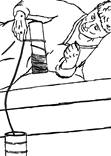 accomplish a task, but to exercise her hand. Do you have a resident like Millie that may be motivated by the exercise or movement aspect of an activity to maintain the ability that he or she has? You might consider Yarn Winding on a Pringles Can.
accomplish a task, but to exercise her hand. Do you have a resident like Millie that may be motivated by the exercise or movement aspect of an activity to maintain the ability that he or she has? You might consider Yarn Winding on a Pringles Can.
| Goal: To wind three rows of yarn around a Pringles Can independently once started… |
Goal: To wind yarn around a Pringles can with total physical assistance… |
Goal: To wind yarn around a Pringles can with physical and verbal prompting… |
Residents with whom to try Yarn Winding on a Pringles Can
| Resident | Who will gather materials and/or construct project? |
Staff /Volunteer to work with resident? When? |
|
|
|
|
|
|
Progress Note: See page 7 for details regarding this four-part implementation procedure, which can become the basis of a Progress Note, stating “When I tried Yarn Winding on a Pringles Can with _________________, the following occurred… |
1. Observation: |
2. Assessment: |
3. Creativity: |
4. Sensitivity: |
Culture Change Implementation: Place Winding on a Pringles Can in labeled Activity Project Bag left in resident’s room for CNA, etc. use.
Yarn Winding into a Ball
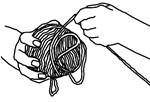 The final way to do Yarn Winding in addition to Spool Winding, Yarn Winding on a Donut Shape, Yarn Winding on a Tube, and Yarn Winding on a Pringles Can is simply to wind yarn into a ball. Some residents have the arm and hand dexterity to actually wind yarn that has been looped around the back of a chair. Here's how you set this up. Occasionally, when you buy yarn at the store, it will be in folded in half. When the yarn is in this format, you can slip it over the back of a chair, as illustrated.
The final way to do Yarn Winding in addition to Spool Winding, Yarn Winding on a Donut Shape, Yarn Winding on a Tube, and Yarn Winding on a Pringles Can is simply to wind yarn into a ball. Some residents have the arm and hand dexterity to actually wind yarn that has been looped around the back of a chair. Here's how you set this up. Occasionally, when you buy yarn at the store, it will be in folded in half. When the yarn is in this format, you can slip it over the back of a chair, as illustrated.
For residents with less mental ability and a smaller range of motion, you might have them wind  yarn from one ball, placed in a coffee can, for example, to another ball. However, for yarn winding into a ball the resident needs to be able to use both hands; one hand to hold and turn the ball of yarn as they are winding it; and the dexterity in the other hand's thumb and index finger to guide the yarn onto the ball. You implement Yarn Winding in a Ball similarly to the way you would implement Yarn Winding on a Donut, or Tube explained above.
yarn from one ball, placed in a coffee can, for example, to another ball. However, for yarn winding into a ball the resident needs to be able to use both hands; one hand to hold and turn the ball of yarn as they are winding it; and the dexterity in the other hand's thumb and index finger to guide the yarn onto the ball. You implement Yarn Winding in a Ball similarly to the way you would implement Yarn Winding on a Donut, or Tube explained above.
| Goal: To do Yarn Winding in a Ball with total physical assistance… |
Goal: To do Yarn Winding in a Ball independently once started… |
Goal: To do Yarn Winding in a Ball for 30 seconds independently once started… |
Goal: To do Yarn Winding in a Ball for one minute… |
Residents with whom to try Yarn Winding in a Ball
| Resident | Who will gather materials and/or construct project? |
Staff /Volunteer to work with resident? When? |
|
|
|
|
|
|
Progress Note: See page 7 for details regarding this four-part implementation procedure, which can become the basis of a Progress Note, stating “When I tried Yarn Winding in a Ball with _________________, the following occurred… |
1. Observation: |
2. Assessment: |
3. Creativity: |
4. Sensitivity: |
Culture Change Implementation: Place Winding on a Ball in an Activity Project Bag left in resident’s room for CNA, volunteer, etc. use.
NCCAP/NCTRC CE Booklet
Forward to Section 19
Back to Section 17
Table of Contents
Top


